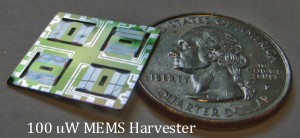Wide-bandwidth, Low-frequency, Low-g Piezoelectric MEMS Energy Harvesters
- Category: Energy, MEMS & BioMEMS
- Tags: ruize xu, sang-gook kim
Our group proposes the piezoelectric energy harvester based on a nonlinear resonator to address the narrow bandwidth issue of conventional energy harvesters. The wide bandwidth and significantly higher power than previously reported devices have been proved by our experiments (Fig. 1), which showed a ~20% bandwidth and a 2W/cm3 power density. Increasing number of researchers have been exploring different nonlinear resonance based designs, including beam stiffening, asymmetry structure, buckled structure, and magnetic restoring force, to name a few. The Duffing mode resonance has been observed in diverse designs, and the wide bandwidth is their shared property. However, the theoretical proof of a wide bandwidth and high-power density energy harvester is not available. By building the electromechanical model for the nonlinear system, we have found the analytical solution of the output power of a nonlinear resonance based piezoelectric energy harvester and have proved a much wider power bandwidth can be obtained by varying electrical load, and the maximum power can be achieved by matching the electrical damping to mechanical damping”. By understanding the advantages of the nonlinear design, we are making new designs to bring it closer to real applications. The two gap between the nonlinear piezoelectric energy harvesters at MEMS scale now are, the operating frequency (>1000Hz) is usually much higher than the frequencies of ambient vibrations (~100Hz), and the excitation level when testing in laboratory (4~5g) is also higher than the common vibration’s amplitude (<0.5g). By optimizing the beam composition, tuning the proof mass and redesigning the beam geometry, we anticipate that our new design will work in the frequency range between 100Hz to 200Hz at the excitation of 0.5g. The new design will be fabricated and tested soon.
